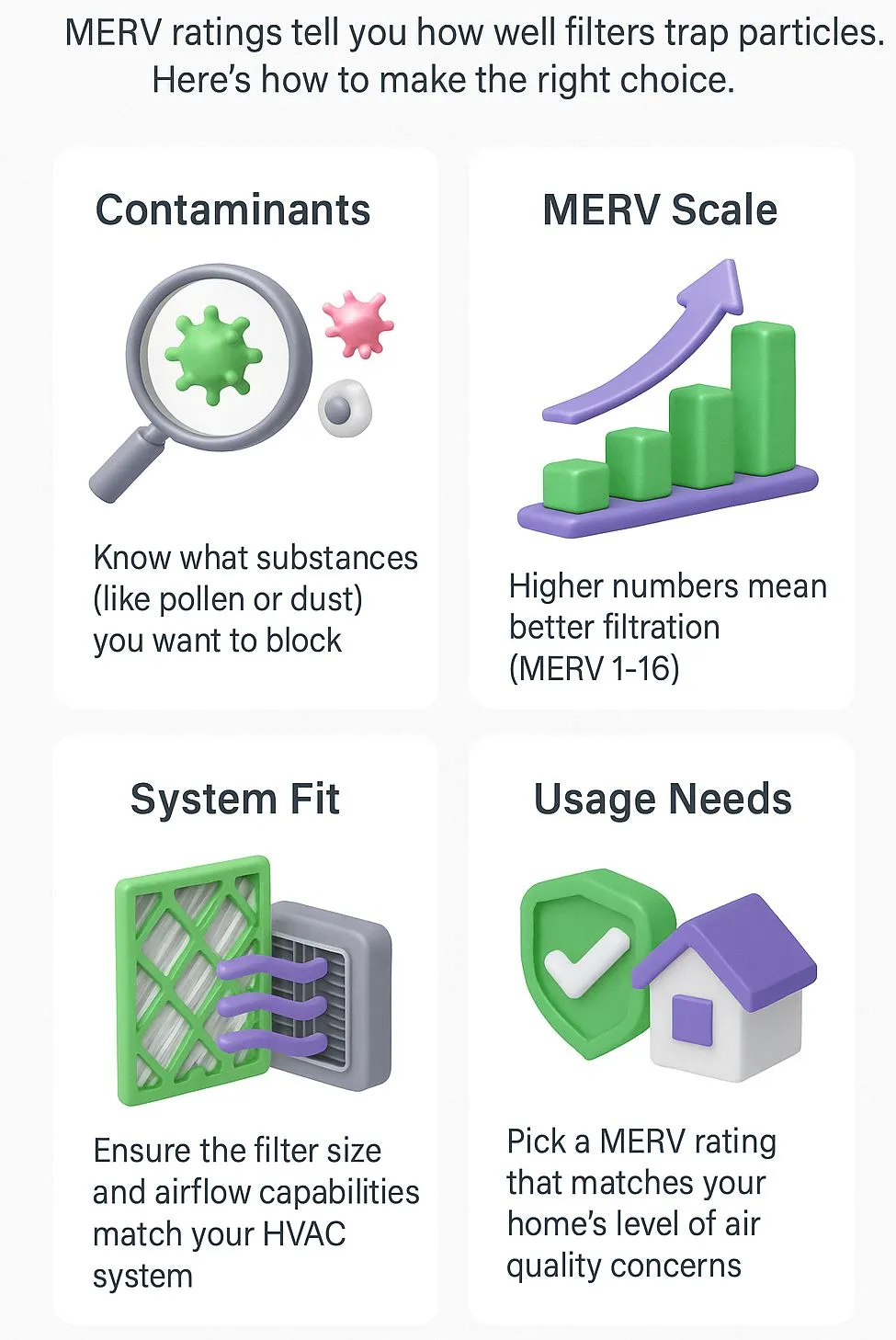Key Takeaways
Know your HVAC system’s capacity. Some systems can’t handle high-MERV filters.
Balance filtration and airflow. Too much restriction = poor performance.
Replace filters every 1–3 months. Higher MERVs may require more frequent changes.
Don’t guess—ask a pro. If you’re unsure, have an HVAC technician evaluate your setup.
What Is a MERV Rating, and Why Does It Matter?
MERV stands for Minimum Efficiency Reporting Value. It’s a scale from 1 to 20 that measures how effectively an air filter traps particles. The higher the number, the smaller the particles it can catch—from dust and pollen to mold spores, smoke, and bacteria.
But there’s a catch: higher MERV doesn’t always mean better for your system. If your HVAC unit isn’t built to handle high-resistance filters, going too high can restrict airflow, raise your energy bill, and shorten your system’s lifespan.
For most homes, the sweet spot is MERV 8 to 13. It all comes down to what you’re trying to filter out—and what your system can support.
Real-World Insight: The Right Filter Makes a Big Difference
From family homes to pet-filled apartments and commercial spaces, we’ve seen firsthand how selecting the right MERV rating delivers measurable improvements.
Atlanta Home with Seasonal Allergies
Started with MERV 6, symptoms persisted
Upgraded to MERV 11 after assessment
Result: 35% fewer airborne allergens and more efficient airflow
Dog Grooming Studio – Denver, CO
Using MERV 8, struggling with hair, odor, and dander
Upgraded to MERV 13 with consistent filter changes
Result: Air smelled fresher, reduced respiratory irritation, HVAC system performed steadily
Low-Ventilation Office Space
Complaints of stuffy air, frequent employee illness
Replaced MERV 7 with MERV 12 and added an air purifier
Result: 42% increase in IAQ score, employees reported feeling more alert and healthier
Data That Backs It Up
National environmental research aligns with what we’ve observed in the field:
MERV 13–16 filters can remove up to 95% of indoor airborne particles
AirNow.govMERV 13 filters trap ≥50% of particles as small as 0.3 microns
EPA Technical SummaryPM2.5 levels in buildings dropped by 31% with MERV 13–14 filters compared to MERV 7–12
CDC Study
How to Choose the Best MERV Rating for You
MERV 1–4: Basic dust control (not ideal for allergies or fine particle removal)
MERV 5–8: Better dust and pollen control; great for standard households
MERV 9–12: Captures mold spores, pet dander, and finer dust
MERV 13–16: Traps smoke, bacteria, and microscopic allergens; ideal for sensitive individuals
MERV 17–20: Typically used in hospitals or clean rooms—requires special HVAC support
Rule of thumb: If you have pets, allergies, or asthma—or live near pollution or wildfire-prone areas—MERV 11–13 is likely your best bet.
Final Word: Make an Informed MERV Choice
Buying the wrong air filter is easy. Buying the right one is smart. It improves air quality, saves energy, and keeps your HVAC system running smoothly. MERV ratings help you make that decision—but only if you understand what they mean.
Before you grab that filter off the shelf, pause and ask: Is this the best MERV rating for my air, my home, and my health?

Frequently Asked Questions: Choosing the Best MERV Rating
What is the best MERV rating for home use?
For most residential HVAC systems, a MERV rating between 8 and 13 offers a strong balance of filtration and airflow. MERV 11–13 is ideal for households with allergies, pets, or respiratory sensitivities.
Can a filter with a higher MERV rating damage my HVAC system?
Yes, if your system isn’t designed to handle higher-efficiency filters, MERV ratings above 13 can restrict airflow, leading to decreased performance or system strain. Always check your system’s specifications before upgrading.
Is MERV 13 too high for my furnace or AC unit?
MERV 13 is safe for many newer systems, but older units or those with lower fan capacity may struggle. When in doubt, consult your HVAC manufacturer or a professional technician.
How often should I replace a MERV 11 or MERV 13 filter?
Typically, every 1–3 months depending on household conditions. Homes with pets, smokers, or high usage may need more frequent changes.
Does a higher MERV filter improve indoor air quality?
Absolutely. Higher MERV ratings trap finer particles, including smoke, bacteria, and allergens, making your indoor air significantly cleaner—especially beneficial for people with asthma or sensitivities.
Understanding Which MERV Rating Is Best? Find Out Before You Buy is essential when improving indoor air quality with long-term benefits. If you’re considering enhanced filtration through HVAC upgrades, services like HVAC Air Purifier Ionizer Installation in Stuart, FL can complement the right MERV rating to purify air even further by neutralizing particles at a molecular level. Pairing this with efficient airflow through duct sealing ensures your system operates without leaks, optimizing performance and extending the filter’s effectiveness. For those navigating home upgrades or marketing solutions, resources like How to Choose the Right Digital Marketing Company and What Services Does a Media Company Offer highlight how professionals in every field—from HVAC to marketing—can tailor solutions based on customer needs and system compatibility.



